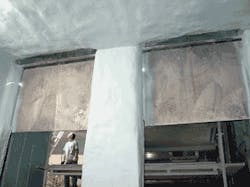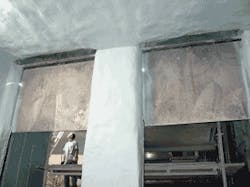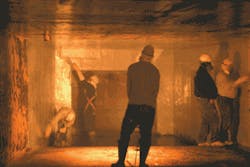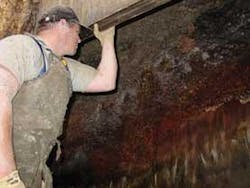The Fresno/Clovis Regional Wastewater Reclamation Facility provides wastewater treatment and disposal for 97 percent of the 520,000 population in the Fresno-Clovis Metropolitan Area, one of the fastest growing communities in California. The 1700 acre property located southwest of Fresno originated in 1891 as a 40-acre disposal area. In the years that followed, the wastewater system successfully evolved through a series of expansions to respond to the needs of a growing population and to comply with increasingly stringent discharge requirements.
The dynamic population growth experienced in the area prompted the City of Fresno to pursue extensive capital improvements, including a two-phased expansion of the plant. In the fall of 1996, the plant completed its first-phase expansion which included replacement of the old headworks. Depending on growth, the state-of-the-art facility was designed to serve area needs for 40 to 50 years.
But after only eight years, a devastating corrosion problem was destroying the relatively new structure. Due to inadequate initial corrosion protection, approximately 50,000 square feet of various headworks chambers and troughs were severely deteriorated from exposure to hydrogen sulfide induced corrosion.
Although the entire structure had been coated with a qualified coating from a major manufacturer when new, the coating was applied too thin to deliver monolithic status - “a barrier without fault” - and post application inspections evidently failed to identify this inadequacy. A mere eight years later, this oversight had resulted in a one to three inch deterioration of the concrete surfaces inside the multi-chambered structure; exposing damaged rebar in some areas and rough aggregate throughout the top of the structures. The structural integrity of some of the steel gates between chambers was also compromised due to severe corrosion on both sides of the walls. The potential for catastrophic failure was imminent in many upper areas of the facility.
“It was our assertion that the original protective coating was applied improperly and ultimately failed,” said Saeid Vaziry, P.E., Chief of Technical Services for the City of Fresno Public Utilities Department. “The corrosion was extensive and if we did not act quickly, we believed the damage would be irreversible.”
Rehab Solutions
The eight headworks chambers and troughs were integrally constructed within the structure, all above grade and aesthetically designed. Construction of a new structure was financially out of the question.
A thorough inspection of the deteriorated structure determined the structures were still sound and salvageable if an appropriate structurally enhancing technology was used. The owner therefore decided to use a “structural protective coating system” to rehabilitate the headworks. Emergency funding was sought and approved.
A thorough review of products and applicators with proven rehabilitation success in similar environments was also conducted. The city selected Raven 400S 100% solids epoxy to restore the flow-split unit. Spinello Companies was chosen as the general contractor to perform general repairs, and provide flow bypass. The contractor then entrusted F&L Concrete Services to apply the protective coating. The city provided construction and project management services.
Bypass Requirements
Taking the plant out of service was out of the question. The city also had an aggressive timeframe for the turnkey repair. It wanted the structure back in operation in 45 days. However, before any work could be done a complex bypass system had to be designed to divert 100% of the influent to a clarifier located approximately 1000 feet away. To accomplish this, eight Godwin 24" dry prime pumps with 24" discharge piping were used (one was a backup). More than 8,000' of 24" piping and assorted fittings were required to complete the bypass operation.
Safety First
Even though the headworks area was taken out of service during the rehabilitation, high levels of hydrogen sulfide were endemic to the plant. Therefore, all potential safety hazards had to be addressed to protect the work crew. The city hired a certified industrial hygienist to oversee the project and make sure the crew was in compliance with confined space entry procedures. The industrial hygienist also had the authority to stop work if conditions were considered dangerous to a crewmember’s health.
“We’ve always been extremely cautious when it comes to working in confined areas. H2S gas can overcome a crew in matter of seconds if they are not properly trained and equipped before entering the area,” said Eric Lewis, President of F&L Concrete Services. “As a matter of fact, we recently hired our own safety specialist to work in conjunction with city appointed safety hygienists on all projects of this nature. You simply can’t be too cautious.”
Rehabilitation Procedures
Coatings rarely fail due to corrosive attack. Fresno’s headworks was no exception. Most coating failures occur due to either poor surface preparation, improper application procedures or inadequate specifications - so Fresno was insistent upon using proven products and crews experienced with the specified product in similar environments. The headworks’ corrosion damage was typical -- ranging from moderate corrosion beneath the low flow levels to severe deterioration in the atmospheric and splash zones of each structure. This necessitated two rehabilitation solutions that could only be firmly identified after thorough cleaning. Cleaning involved sandblasting, decontamination and high-pressure water blasting to all surfaces.
The city specified the entire structure to receive 125 mils (3 millimeters) of Raven 400S. In more heavily deteriorated areas, a base coating consisting of Quadex Aluminaliner, a fiber-reinforced, 100% calcium aluminate aggregate enhanced mortar, was first applied from one to two inches thick as necessary to rebuild severely deteriorated surfaces. Calcium aluminates are high early strength specialty cements resistant to corrosion. Approximately one third of the structures required this composite solution. Raven 400s was then applied after the cementitious basecoat had cured at least 24 hours.
Engineered System
Specifying proven products at an appropriate thickness is essential but not foolproof. Experienced applicators with manufacturer certified equipment are necessary to consistently perform as expected - especially under Fresno’s tight timeframe needs.
F & L used Raven’s proprietary plural component spray application system to ensure a uniform ratio and thickness throughout. Although the epoxy could be applied to a 125 mil thickness in one coat, it was done in two coats to ensure higher quality. Good coating practice suggests that defects inevitable in single coat systems can be encapsulated in a two coat system. A wet film thickness gauge was used systematically throughout the application to ensure uniform coating thickness.
Last but not least, critically important post-application inspection procedures were performed to ensure the coatings’ integrity. These tests were conducted by an independent NACE Inspector and included holiday detection and adhesion testing to confirm the coating was applied monolithically and had attained the necessary thickness and adhesion.






